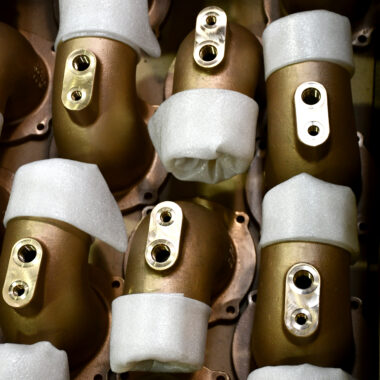Elevate Your Craft: Advanced Techniques for Casting Aluminum Illinois
Elevate Your Craft: Advanced Techniques for Casting Aluminum Illinois
Blog Article
The Art of Light Weight Aluminum Casting: Enhancing Your Abilities for Superior Outcomes
Aluminum casting is a craft that demands precision, patience, and a deep understanding of the techniques involved. As artisans and developers, our pursuit of excellence in light weight aluminum spreading is a trip that calls for devotion and a constant mission for mastery.
History of Aluminum Spreading
Light weight aluminum spreading, a procedure with origins tracing back centuries, has actually played a substantial duty in the growth of different markets. When it emerged as a crucial production method, the history of light weight aluminum spreading dates back to the 19th century. The usage of aluminum in casting procedures reinvented industries such as auto, aerospace, and building and construction as a result of its lightweight homes and corrosion resistance.
Among the earliest uses aluminum casting can be mapped to the production of pots and pans and decorative things. As improvements in technology took place, aluminum spreading broadened its reach to include engine parts, structural components for aircraft, and detailed styles in architectural frameworks. The flexibility and adaptability of aluminum spreading enabled the creation of elaborate forms and designs that were formerly unattainable with other producing methods.
Today, light weight aluminum spreading remains to be a foundation of contemporary industrial procedures, enabling the manufacturing of facility components with high accuracy and performance (casting aluminum illinois). Comprehending the historic advancement of aluminum spreading provides valuable understandings into its long-lasting relevance and continuous advancement in the commercial landscape
Essential Tools and Tools
Utilizing specialized tools and devices is necessary in attaining optimum lead to the aluminum casting process. The fundamental devices needed for light weight aluminum spreading include a crucible for melting the aluminum, a heating system to reach the needed temperature levels, and mold and mildews to shape the molten metal. Crucibles, generally made from graphite or ceramic materials, should endure high temperatures to stop contamination of the aluminum. Furnaces are essential for heating the aluminum to its melting point, generally around 660 levels Celsius, guaranteeing it is in a fluid state for casting. Molds can be found in numerous types, such as sand molds or die-casting molds, to offer the light weight aluminum its preferred shape.
Protective equipment is essential to protect against injuries from the high temperatures entailed in the casting process. On the whole, having the right tools and devices is extremely important for achieving specific and top quality aluminum spreadings.
Understanding the Casting Process
Having actually gotten the important devices and tools for aluminum casting, the next action in the direction of excellence lies in understanding the intricate casting process. casting aluminum illinois. The casting procedure entails browse around here a collection of steps that require ability, focus, and accuracy to detail to guarantee exceptional outcomes

As soon as the light weight aluminum has actually solidified, thoroughly eliminating the spreading from the mold without causing any kind of damages is essential. Understanding each action of the spreading process is essential to producing top quality aluminum castings.

Advanced Techniques and Tips
Mastering detailed details and carrying out advanced methods can boost the quality and precision of light weight aluminum casting processes. One sophisticated strategy is making use of ceramic mold and mildews, which give a smoother surface finish and higher dimensional precision compared to conventional sand mold and mildews. In addition, employing vacuum spreading approaches can help in reducing porosity in the final spreading, causing more powerful and more long lasting light weight aluminum components.
An additional idea is to pre-heat the mold and mildews prior to putting the molten aluminum to improve the flowability of the metal and decrease the probability of issues such as cool shuts or misruns. Using cool blocks tactically can assist manage the solidification rate of the aluminum, minimizing internal stresses and boosting the total mechanical buildings of the actors component.
Finally, grasping the art of gating and risering is essential for achieving sound spreadings. Appropriately created gating systems and risers can help prevent contraction defects and guarantee an attire flow of metal throughout the mold and mildew cavity, causing remarkable casting high quality. By incorporating these innovative methods and ideas into your aluminum casting procedure, you can improve the consistency and accuracy of your end products.
Troubleshooting Common Spreading Issues
Addressing common casting concerns calls for a methodical strategy to determine and correct variables impacting the Click Here quality of aluminum castings. Additionally, improper mold filling can cause issues like misruns or cold shuts, resulting in incomplete castings. By understanding these common spreading troubles and applying reliable remedies, light weight aluminum wheels can improve the general high quality and stability of their castings.
Conclusion
In conclusion, understanding the art of light weight aluminum spreading needs a deep understanding of the history, important tools, and progressed strategies included in the process. By honing your abilities and troubleshooting usual spreading problems, you can achieve superior outcomes in your spreading projects. Continual technique and commitment are essential to boosting your capacities and creating top quality aluminum spreadings.
Grasping each action of the spreading process is vital to creating top quality light weight aluminum spreadings.
Additionally, using vacuum weblink spreading techniques can help lower porosity in the final casting, resulting in stronger and extra long lasting aluminum components.
Addressing usual casting concerns requires a methodical approach to recognize and rectify variables impacting the top quality of aluminum spreadings. By understanding these typical spreading problems and applying effective options, aluminum casters can boost the overall high quality and honesty of their castings.
By refining your abilities and fixing usual spreading issues, you can attain exceptional outcomes in your casting jobs.
Report this page